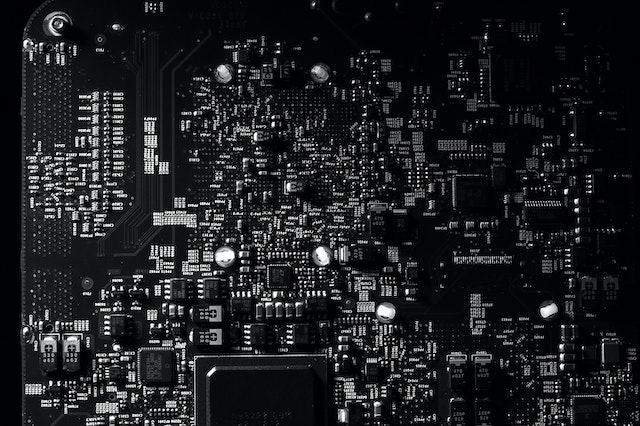Understanding the Role of Indium Phosphide in Semiconductor Devices
Immersed in the realm of semiconductor industry, particularly in RF technology, is a binary compound known as Indium Phosphide (InP). This intriguing material, born from a harmonious marriage between indium and phosphorus, stands tall amidst other materials like silicon or gallium arsenide. It brings forth to the table an astonishing velocity of electrons that enables devices to perform at heightened frequencies. Such prowess makes it nothing short of ideal for high-performance applications such as photonic integrated circuits.

The charm of InP doesn’t cease with its remarkable performance within electronics alone; it extends into realms unseen by the naked eye. As we navigate through our technologically advanced world brimming with home electronics, this compound has become increasingly prevalent due to its distinctive properties and advantages. You see, Indium Phosphide possesses a direct bandgap enabling efficient light emission – an attribute making it nothing less than perfect for LEDs and other optical frequency devices where energy efficiency reigns supreme.
Diving deeper into this vast ocean of technology reveals yet another arena where InP thrives – Photonic Integrated Circuits (PICs). Representing a significant shift toward all-optical systems from electronic integration, PICs offer numerous benefits ranging from reduced power consumption to increased data transmission rates. The inherent qualities nestled within Indium Phosphide align perfectly with these demands while promising impressive thermal stability. Even under harsh conditions that would make others falter – InP remains steadfastly reliable: further cementing its irreplaceable role as an essential material within our modern technological landscape.
“Exploring the High-Performance Attributes of Indium Phosphide Semiconductors”
The binary semiconductor, Indium Phosphide (InP), has become a point of intense focus and interest within the electronics industry. This surge of attention is no accident – rather it’s due to its superior characteristics when pitted against other semiconductors like silicon and gallium arsenide (GaAs). The high-performance traits displayed by InP are manifold; encompassing a broad band gap, high electron mobility, as well as robust thermal stability.

These distinctive features elevate it to an ideal status for deployment in diverse electronic devices such as LEDs and transistors. Moreover, the lattice arrangement of InP harmonizes seamlessly with other materials utilized during wafer-based device manufacturing processes. This ensures minimal defect occurrence while simultaneously boosting overall device performance.
Where Indium Phosphide truly asserts dominance is within the realm of radio frequency (RF) technology. The capacity for high-frequency operation exhibited by devices constructed from InP far exceeds those fabricated from silicon or GaAs counterparts. It renders them particularly advantageous in RF applications where speed reigns supreme along with efficiency.
This exceptional semiconductor also touts incredible optical properties that cannot be ignored – courtesy of its direct bandgap feature which enables efficient conversion of electrical signals into their optical equivalents without significant loss accruing in the process.
Indium Phosphide’s proficiency isn’t restricted to fixed frequencies either; it extends even unto laser technologies including continuous wave lasers and pulse lasers which significantly benefit from this characteristic. Its potent interaction with light facilitates effective utilization within photonic integrated circuits functioning as modulators or detectors among others components; thereby promoting faster data transmission rates over greater distances sans degradation in signal quality.
As we accelerate towards increasingly advanced technological solutions on our ongoing journey, the significance attached to Indium Phosphide will only escalate further than ever before.
“How RF Technology Benefits from Indium Phosphide”
In the sphere of RF technology, Indium Phosphide (InP) has caused quite a stir. Its unique properties make it an ideal candidate for high-frequency applications. One pivotal attribute is its wide bandgap, which permits operation at higher frequencies and temperatures compared to other semiconductor materials – a characteristic that endows InP-based devices such as amplifiers with the capacity to deliver robust power outputs while sustaining excellent performance over a vast bandwidth.
The companioning of indium gallium arsenide (InGaAs), another member of the III-V compound semiconductors often coupled with InP, further bolsters these capabilities by granting superior electron mobility.
The introduction of InP into microelectronics has sparked a revolution in the field, particularly in RF technology where high-frequency operations are paramount. Take integrated circuits made from this material for instance; they can tackle rapid pulse rates more efficiently than those built with conventional substances like silicon or gallium arsenide. This comes hand-in-hand with certain drawbacks including cost and fabrication intricacies; however, relentless research efforts are aimed at counteracting these challenges whilst maximizing the potential benefits offered by this prospective material.
Indium Phosphide also takes center stage in fiber optic communication systems owing to its prowess to generate and detect light within 1.3-1.55 micrometer range – making it perfectly suited for long-distance transmission through optical fibers. The compatibility factor of InP allows seamless integration into current manufacturing processes without necessitating significant alterations or investments towards new machinery or technologies.
Despite facing several implementation-related hurdles, Indium Phosphide continues to significantly influence both RF technology and wider fields encompassing electronics and photonics – truly manifesting itself as a game-changer.
“The Impact of Indium Phosphide on Modern Home Electronics”
The realm of modern home electronics is profoundly indebted to the pivotal role played by Indium Phosphide (InP), a material celebrated for its unparalleled electro-optical properties. In the arena of optoelectronic substances, InP has been a linchpin in ushering forth an era of high-caliber appliances such as laser diodes and photonic integrated circuits.
The supremacy of indium phosphide primarily springs from its direct band gap and lattice constant features, which render it perfectly suitable for these applications. The defining hallmark of any semiconductor substance is undoubtedly its energy gap or bandgap. When this gap assumes a direct form like that exhibited by an InP device, electrons find themselves effortlessly transitioning from the conduction band into the valence one, thus emitting light with remarkable efficiency.
This unique attribute propels InP into becoming an indispensable component in crafting light-emitting devices such as LEDs and laser diodes – entities that have become ubiquitous fixtures within our domestic spheres today. Moreover, boasting an approximate value around 1.2 electron volts at room temperature, this energy chasm expertly accommodates numerous optical communication systems’ necessities.
Indium Phosphide’s other merit lies hidden within its lattice constant; aligning harmoniously with other semiconductors enables seamless assimilation into diverse device structures. This congruity accelerates the fabrication process of intricate layered edifices on an InP wafer without eliciting undue tension or imperfections during manufacturing procedures – yet another testimony to why it holds undisputed reign among high-performing options available in today’s semiconductor materials landscape.
“The Superiority of Indium Phosphide in Photonic Integrated Circuits”
In the complex labyrinth of photonic integrated circuits, a new champion has emerged from the shadows – Indium Phosphide (InP). This dark horse deftly outmaneuvers traditional stalwarts such as silicon and gallium arsenide, courtesy of its superior electron mobility. InP substrates fuel devices with higher power and speed, placing them leagues ahead in performance.
The prowess of InP does not stop at mere electron mobility. It infiltrates into optoelectronics too where it slashes power requirements due to innate efficiency. Imagine bipolar transistors crafted from InP flexing high-frequency performance characteristics; they become communication system darlings almost instantly.
Another feather in the cap for this rising star is its thermal decomposition properties that align seamlessly with other materials used in semiconductor manufacturing processes. This compatibility shields components against strain during temperature swings thereby fortifying device reliability over time. Stepping up further, HBT or heterojunction bipolar transistors conceived on InP substrates are touted to deliver exceptional performances at higher frequencies compared to their brethren built on alternative substances.
Indium Phosphide’s realm expands even further into multiplexing applications within contemporary communication systems where it delivers an awe-inspiring 5-fold increase in data transmission rates vis-a-vis conventional methods. Its unique physical traits pave way for efficient light signal manipulation thus boosting bandwidth capacity and overall system performance without nudging energy consumption upwards.
Despite being a relatively fresh face amidst more tenured materials like silicon or gallium arsenide, it’s evident that harnessing the potential benefits tied to InP could trigger paradigm shift across various facets within electronics engineering sector moving forward.
“Comparing Indium Phosphide with Silicon and Gallium Arsenide Semiconductors”
In the intricate world of photonic integrated circuits – key players in optical communications – two semiconductors reign supreme: Indium Phosphide (InP) and Gallium Arsenide (GaAs). InP’s wider energy band gap, compared to GaAs, makes it a prime candidate for use in devices operating at shorter distances such as field effect transistors or heterojunction bipolar transistors. Notably, InP exhibits greater electron velocity than silicon-based devices – a feature that enhances performance.
The real-world application of these semiconductors is heavily influenced by their efficiency and power density. When engaging with research comparing GaAs and InP, one finds both materials boast high levels of efficiency; however InP commands superior power densities making it a formidable force within RF technology where output maximization is crucial.
Peeling back another layer reveals an intriguing angle – biological impacts associated with GaAs and InP have come under scrutiny. Animal studies involving rats and mice suggest prolonged exposure may result in accumulation within the liver and spleen over time; yet this area begs further exploration. Regardless of potential health concerns stemming from these substances themselves, there’s no refuting their game-changing influence on modern electronics. From everyday home appliances to cutting-edge communication systems – they’ve indelibly shaped our world through their unique properties.
“The Use of Indium Phosphide in Laser and Optical Frequencies”
In the arena of semiconductor optical amplifiers, Indium Phosphide (InP) has been a character of significance. Its high electron mobility and lower drive voltages have cut a distinguished figure in this domain. This maketh devices constructed from InP capable of grappling with higher frequencies – an advantage especially potent in laser and optical applications. The findings from our research point towards a superior performance by InP-based devices when pitted against those fashioned out of silicon or even gallium arsenide.
Notwithstanding, a meticulous probe was initiated by the National Institute for Occupational Safety to discern the impacts of employing different semiconductors. A comparative analysis revealed that exposure to indium compounds induced a delayed pleural effusion akin to those caused by other matter like silicon and gallium arsenide – thus casting light on one disadvantage tethered to using these types of materials in electronics manufacturing procedures.
Yet, it would be remiss not to consider the merits proffered by Indium Phosphide semiconductors amid some disadvantages. Their high carrier mobility renders them well-suited for usage in cutting-edge technologies such as photonic integrated circuits found within contemporary home electronic systems. Moreover, they boast superior thermal conductivity compared with their counterparts- an attribute that significantly bolsters device performance and reliability under extreme circumstances.
“LEDs, Transistors, and the Role of Indium Phosphide”
Charmingly complex yet offering superior properties is Indium Phosphide, a semiconductor material that’s an integral player in the workings of LEDs and transistors. These constituents form the bedrock for a myriad of devices, inclusive but not limited to optoelectronic integrated circuits. The singular traits exhibited by Indium Phosphide pave the way for heightened performance levels, thereby leading to greater efficiency within these electronic apparatuses.
Intriguing research has ventured into exploring potential health impacts tied with exposure to Indium Phosphide. In an intriguingly drawn-out 2-year inhalation study, fluids were garnered from subjects exposed over both brief spans (14 days) and extended durations (28 days). Unveiled findings implied that enduring exposure might instigate alterations in mediastinal lymph nodes due to aspiration of soluble forms of this compound. This highlights the importance of stern adherence to proposed limits when handling such material.
Further observations unraveled that Indium phosphide partakes in interactions with cytochrome c oxidase – an enzyme tasked with propelling cellular respiration processes within our bodies. A point worth noting is this interaction could potentially birth highly reactive hydroxyl radicals which may unleash adverse effects on biological tissues if contact surpasses set safety parameters. Therefore, while leveraging its benefits for technological progression, judicious management becomes imperative when dealing with indium phosphide as part of occupational or environmental exposures.




Comments are closed.